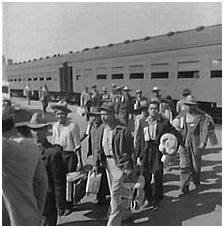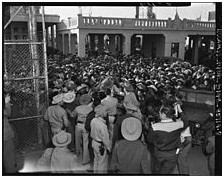
"Bracero" redirects here. For the sportscaster, see Rafael Bracero.

The first Braceros arrive in Los Angeles by train in 1942. Photograph by Dorothea Lange
The Bracero Program (named for the Spanish term bracero, "strong-arm") was a series of laws and diplomatic agreements, initiated by an August 1942 exchange of diplomatic notes between the United States and Mexico, for the importation of temporary contract laborers from Mexico to the United States.
American president Franklin D. Roosevelt met with Mexican president Manuel Ávila Camacho in Monterrey, Mexico to discuss Mexico as part of the Allies in World War II and the Bracero Program. After the expiration of the initial agreement in 1947, the program was continued in agriculture under a variety of laws and administrative agreements until its formal end in 1964.
History

"Mexican workers await legal employment in the United States", Mexicali, 1954
In the 1930s, during the Great Depression, more than 500,000 Mexican Americans were deported or pressured to leave, during the Mexican Repatriation. There were fewer Mexican Americans available when labor demand returned with World War II.
The Bracero Program was initially prompted by a demand for manual labor during World War II and began with the U.S. government bringing in a few hundred experienced Mexicanagricultural laborers to harvest sugar beets in the Stockton, California area. The program soon spread to cover most of the United States and provided workers for the agricultural labor market (with the notable exception being Texas, which initially opted out of the program in preference to an "open border" policy, and was denied braceros by the Mexican government until 1947 due to perceived mistreatment of Mexican laborers[1]). As a corollary, the railroad bracero program was independently negotiated to supply U.S. railroads initially with unskilled workers for railroad track maintenance but eventually to cover other unskilled and skilled labor. By 1945, the quota for the agricultural program was more than 75,000 braceros working in the U.S. railroad system and 50,000 braceros working in U.S. agriculture at any one time.
The railroad program ended with the conclusion of World War II in 1945.
At the behest of U.S. growers, who claimed ongoing labor shortages, the program was extended under a number of acts of congress until 1948. Between 1948 and 1951, the importation of Mexican agricultural laborers continued under negotiated administrative agreements between growers and the Mexican Government. On July 13, 1951, President Truman signed Public Law 78, a two-year program that embodied formalized protections for Mexican laborers. The program was renewed every two years until 1963 when, under heavy criticism, it was extended for a single year with the understanding it would not be renewed. After the formal end of the agricultural program in 1964, there were agreements covering a much smaller number of contracts until 1967, after which no more braceros were granted.



















